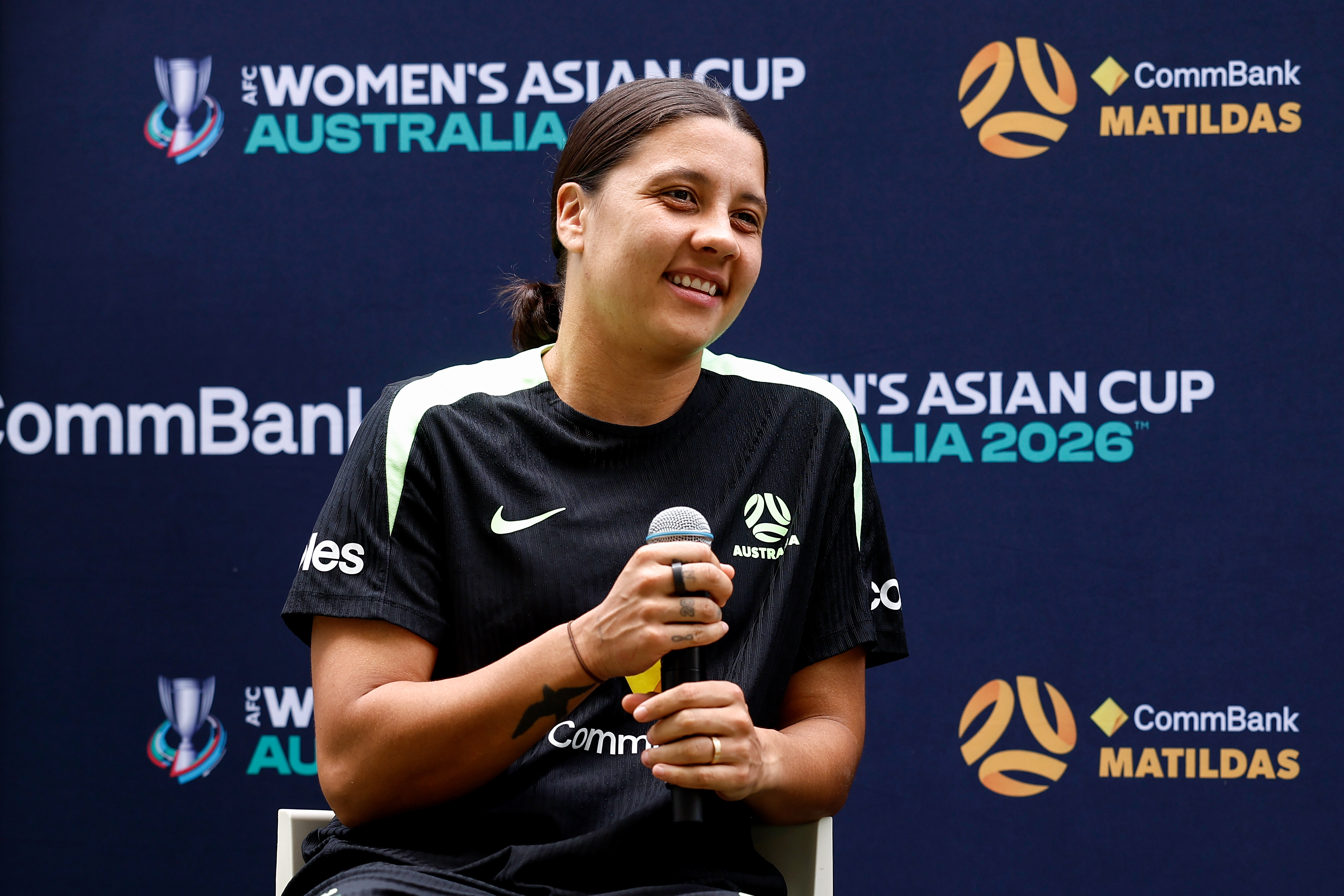

The AFC Womens Asian Cup heads to Australia next year, as Australia get set to host their second major womens football competition in three years after the 2023 World Cup.
From March 1-21 2026, 12 nations will take part in the competition, with a total of 27 matches taking place across Perth, Sydney and the Gold Coast.
Tournament Overview
When does the tournament kick off?
The Women's Asian Cup will start on March 1 2026, with the final scheduled for March 26.
Who are the hosts and what are the venues for the 2026 Women's Asian Cup?
Australia host the 2026 tournament for the first time since 2006, where they finished runners-up.
Four football associations initially submitted their interest to host the tournament however following the withdrawals of Jordan, Saudi Arabia and Uzbekistan bids, Australia was selected as the host nation in March 2024.
The 27 matches will be split across three Australian venues:
Perth, Western Australia
Perth Stadium: 60,000 capacity
Perth will host the opening ceremony match on 1 March, featuring the Matildas, and a semi-final.
Perth Rectangular Stadium: 20,500 capacity
Perth Rectangular Stadium will host 6 group stage matches and 2 quarter-finals
Sydney, New South Wales
Stadium Australia: 79,500 capacity
Stadium Australia, Sydney, will host one group stage match featuring the Matildas, two Quarter-finals, a Semi-final and the Final.
Western Sydney Stadium: 30,000 capacity
Six group stage matches will be played here
Gold Coast, Queensland
Gold Coast Stadium: 28,000 capacity
Four group stage matches to be held on the Gold Coast, including the Matildas second group match.
What is the format of the Women's Asian Cup?
The 12 qualified teams are split into three groups of four, which were seeded based on world rankings.
Group A: Australia, South Korea, Philippines, Iran
Group B: North Korea, China, Uzbekistan, Bangladesh
Group C: Japan, Vietnam, Chinese Taipei, India
The top two teams from each group will qualify automatically, with the final two spots in the last eight being awarded to the best third-placed teams.
This will then progress in the usual way to semi-finals and a final.
There are also implications for qualification for the 2027 Womens World Cup. With six spots available, the semi-finalists will automatically qualify. The four teams eliminated in the quarter-finals will then play off against each other, with the two winners advancing to the inter-confederation play-offs.
The teams
Australia (Hosts, world ranking: 15)
The Matildas will be looking to add another title to their trophy cabinet, having won the Asian Cup only once before in 2010.
Australia, now under the guidance of former Arsenal manager Joe Montemurro, have the home advantage, which they used to great effect during the 2023 Womens World Cup when they reached the semi-finals before being knocked out by England.
The squad boasts a wealth of world-class talent, with plenty of familiar faces for Womens Super League fans.
Sam Kerr, the Golden Boot winner at the last tournament, will be hoping to return to her best by March. After suffering an ACL injury in December 2023, she was sidelined for 20 months before finally making her Chelsea comeback in September this year and returning to international duty soon after. While she has yet to regain the consistent fitness needed to start regularly, her wealth of experience will be irreplaceable next year.
Australias defensive and midfield core is equally strong. Chelseas Ellie Carpenter and Arsenal trio Steph Catley, Kyra Cooney-Cross and Caitlin Foord are headline names, while the WSL is also represented by Alanna Kennedy (London City Lionesses), Katrina Gorry (West Ham) and Charli Grant (Tottenham).
China PR (Reigning champions, world ranking: 16)
China remain a dominant force in Asian Cup history with a record nine titles, including their most recent triumph in 2022.
Their recent global form has been less consistent. At the 2023 Womens World Cup, China suffered a disappointing group-stage exit, including a heavy 6-1 loss to eventual finalists England, failing to progress beyond the group stage of the competition for the first time.
Despite that setback, China arrive at this Asian Cup as the reigning champions. Their 2022 victory was one of the most dramatic in the competitions history, as they overturned a 20 deficit to beat South Korea 3-2 in the final.
Their pedigree in this competition keeps them among the favourites once again.
Japan (world ranking: 8)
Based on world rankings alone, Japan go into this tournament as favourites. Their squad is packed with talent familiar to WSL fans, with several players now established at top English clubs.
Among the standout names are Maika Hamano of Chelsea, Yui Hasegawa, Aoba Fujino and goalkeeper Ayaka Yamashita of Manchester City, Manchester United's Hinata Miyazawa and Kiko Seike who shone for Brighton last season. This core has helped Japan thrive on the world stage in recent times.
Japan lifted the Asian Cup in 2014 and 2018, and reached the semi-finals in 2022 before a narrow penalty shootout defeat to China, while their World Cup victory in 2011 remains historic.
At the 2023 World Cup, Japan delivered arguably the most memorable moment of the tournament with a 4-0 victory over eventual champions Spain in the group stage. They went on to beat Norway in the round of 16 before falling to Sweden in the quarter-finals.
Japan will always go into this tournament with a target on their back and their 2022 heartbreak will only make them more determined.
North Korea (world ranking: 10)
This team is bursting with history, and they remain one of the competition's powerhouses alongside Japan, China and Australia. North Korea are three-time champions, lifting the Asian Cup in 2001, 2003 and 2008. North Korea also reached the quarter-finals of the 2007 World Cup.
They have won three of the last nine under-17 Womens World Cups. including the most recent one in 2025. Young girls in North Korea get professional coaching when theyre in school and there are huge incentives to represent their country at international level. This pathway of talent creates a very impressive team.
Perhaps unsurprisingly, every player in the current squad competes domestically.
South Korea (world ranking: 21)
South Korea achieved their best-ever finish at the last Asian Cup, finishing as runners-up after a narrow 3-2 defeat to China in the final.
They have qualified for four World Cups, reaching the round of 16 in 2015 and appearing again in 2003, 2019 and 2023. South Korea have also featured in every Asian Cup since 2001 and remain consistent contenders in the region.
Vietnam (world ranking: 37)
Vietnam have featured in every Asian Cup since their debut in 1999 and hosted the tournament twice, in 2008 and 2014.
They are a major force in Southeast Asia, although they have yet to progress beyond the group stage on the Asian stage.
Vietnam reached their first World Cup in 2023 but faced a difficult group and suffered heavy losses against the USA, the Netherlands and Portugal.
Philippines (world ranking: 39)
The Philippines made history by qualifying for their first Womens World Cup in 2023. Although they exited in the group stage, a 10 win over co-hosts New Zealand delivered an unforgettable moment of national pride.
Their rise has been rapid. They reached the semi-finals of the 2022 Asian Cup, losing to South Korea, and that run secured their historic World Cup debut. The squad will hope to build on that momentum at this years tournament.
Chinese Taipei (world ranking: 42)
Chinese Taipei once dominated the Womens Asian Cup, winning three consecutive titles between 1977 and 1981, and they will arrive down under hoping to revive that golden era.
After periods of absence, they returned to the tournament in 2022, losing on penalties in the quarter-finals. Their qualification for 2026 was emphatic, topping their group with a perfect record and standout performances from forward Su Yu-hsuan.
This tournament marks an exciting opportunity for Chinese Taipei to aim to re-establish themselves among Asias elite.
Uzebekistan (world ranking: 52)
Uzbekistan return to the Womens Asian Cup for the first time since 2003 after a dramatic qualifying run that ended with a 42 penalty shootout win over Nepal.
They enjoyed big victories over Sri Lanka and Laos in qualifying before surviving a tense shootout thanks to goalkeeper Maftuna Jonimqulovas heroics. Their qualification is a major step forward, especially as they prepare to host the 2029 edition, and they are quickly becoming fan favourites back home.
India (world ranking: 63)
India enter the draw from the lowest pot, but this tournament marks the first time they have qualified for the tournament on merit. Womens football in India continues to face significant challenges, with limited funding, infrastructure and opportunities compared to the mens game, despite the women often outperforming them internationally.
India hosted the 2022 Asian Cup but were forced to withdraw during the group stage due to a COVID-19 outbreak within the squad. After that heartbreak, this edition offers a fresh chance to reignite national interest and inspire a new generation of girls to play football.
Iran (world ranking: 70)
Iran return to the Asian Cup for only the second time after claiming the final qualification spot, defeating Jordan again, as they did ahead of the 2022 edition.
Despite being the only qualifying team to lose a match, Iran's resilience is notable. Their head coach Marziyeh Jafari said: "I am really happy that we were able to make the hearts of the Iranian people happy. Qualifying for the AFC Asian Cup was not easy!
Bangladesh (world ranking: 104)
Bangladesh will make their first ever Asian Cup appearance in 2026 after a qualifying campaign that showcased the progress of their grassroots development.
Despite arriving as the lowest-ranked side, the young team will bring momentum from winning all three qualifiers, scoring 16 goals and conceding only once.
The tournament marks a special moment for women and girls football in Bangladesh.
TOPICS

